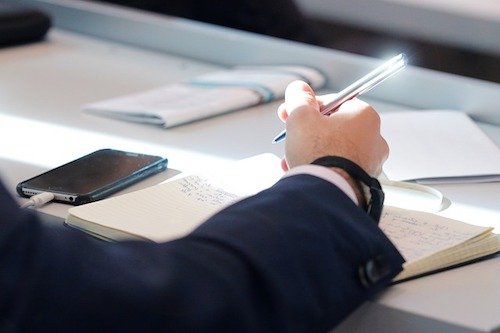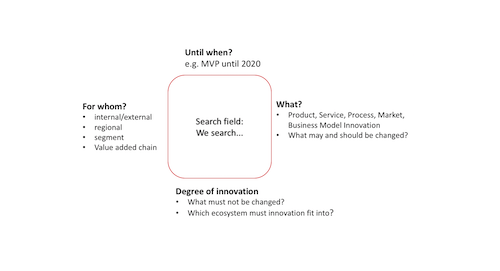How does an innovation workshop work?
An innovation workshop serves to find concrete ideas for innovations and to develop initial concepts. In this article you can read how an innovation workshop at Lead Innovation works.

1. Definition of the goal for the workshop
Even before the workshop, it should be determined what the aim of the workshop is and what the framework conditions for it are. The individual parts of this framework are called search fields:
- What do we want to invent (type of innovation)?
- For whom would we like to invent something?
- How new may the innovation be for the company (degree of innovation)?
- Until when should the innovation be in the market?

The example of a pharmaceutical company shows why it is so important to define the limits and framework conditions in advance and to communicate them clearly. Within the framework of an Innovation Challenge and an Innovation Workshop, the participants invented an aspirin beer that should make headache-free drinking possible. Of course, this innovation does not fit in with a pharmaceutical company and was rejected. The management was dissatisfied with the result and the employees were dissatisfied because nobody had told them that this idea was not allowed.
The goal of the workshop or search field must therefore be clear to all team members at the beginning of the workshop. It is of no use to a company to create exciting ideas in the workshop that ultimately do not fit the company or are not really sought after.
2. Presentation of the status quo
The innovation workshop itself begins with the presentation of the current situation of the topic. If a service is to be innovated, for example, the current Customer Journey or the current Experience Map is presented. When it comes to a product or a technology, you present the current status quo of the respective technology.
3. Creativity session: Nagging à Perfect Solution
In a first creativity session we then have several small groups of people complaining about the current situation (= nagging). The aim is for the team to really talk about the topic and collect all the negative aspects of the current situation.
The individual groups then consider what the perfect solution might be for all these problems (= Perfect Solution). So we transform the nagging into the Perfect Solution. However, only solutions that are in the previously defined search field are allowed. Within this framework everything is allowed - no matter if it is technically difficult or not. There are no limits here, creativity can be given free rein.
After the creativity session, the ideas are clustered and presented. The individual small groups pitch their Perfect Solution to each other and try to sell it to the whole team. The other groups are asked to ask questions about the solution and give feedback.
4. Creativity session: Intergalactic Thinking
In a second creativity session we continue with "Intergalactic Thinking". In this exercise, time pressure is important to encourage creativity. The team members should not think deeply, but react spontaneously.
# Creative questions
To this end, we first ask the team a question that has nothing to do with the topic or the desired innovation - for example:
- What does Steve Jobs find in Elvis Presley´s Garage?
- What is Elvis Presley doing in the Alps?
- What does Niki Lauda find in Lady Gaga's living room?
You can of course be creative with regard to the question. It is important to make sure that you find something or do something at the location and that all workshop participants know the people mentioned.
For example, we once had an innovation workshop in Asia, where participants asked who this Mr. Presley was and why we were looking into his garage. In the run-up to an innovation workshop, we therefore always find out which people fit well so that there is no confusion.
# 10 things x 10 properties = 100 relevant properties
The team then lists 10 things that Steve Jobs, for example, finds in Elvis Presley's garage. After that the reference to the topic is made again: For each of the 10 things, 10 properties are searched for, which could be relevant for the product/service in question.
A single property isn't very creative yet, but if you list 10 properties for each of 10 things that fit the product or service, you'll end up with a total of 100 properties that the product is supposed to have.
# Clustering, Concept und Pitch
In a next step, useful properties are selected from the 100 properties, clustered, a solution developed and the concept presented. An example: Steve Jobs finds a Cadillac in the garage. The Cadillac is fast and has a good design. For example, the "fast" feature can mean that the service has to respond particularly quickly to enquiries.
5. Creativity session: headstand method
As an alternative method or additional method in a 2-day innovation workshop, we also often use the headstand method. The team members first develop a service or a product that no customer would use or buy, for example:
- What would be the worst service/product you can imagine?
- What would you have to do to make complaints hail or customers turn their backs on your company?
Then the whole thing is turned upside down by positively transforming the individual negative characteristics. A confusing, ugly user interface then becomes, for example, a well-structured service page with clear navigation and appealing design.
6. Investment-Session: Idea evaluation
Now that some concepts and ideas have been collected in the exercises, the next step is an investment session. Each team member is given 500 dollars of a fictitious currency that the company would like to introduce (e.g. time dollar, VW dollar). Each team member then invests in the concept that holds it most promising. In this way you get a first ranking.
In addition, ideas are evaluated according to the following criteria:
- Quick Win:What could we simply implement immediately or in the next one to two years?
- Most Promising:Which concepts offer great potential for a new product or service?
- Futuristic:Which concepts, which are currently not yet possible, would help us, for example, in ten years to a real competitive advantage?
7. Elaboration and presentation of final concepts
In the final phase of the innovation workshop, the team will again be divided into three groups to develop final concepts for Quick Wins, Most Promising and Futuristic. As a result, at least one concept should be presented in each category, which answers the following questions:
- What is this concept or idea called?
- What problem does it address?
- How does it solve this problem?
- What is the USP?
- What are the first steps in implementation?
- By when will the concept be implemented?
After the concepts have been pixeled, they are optimized again taking into account the feedback of the other team members.
Conclusio: Innovation workshop brings ready-made concepts to the table
Every participant of the innovation workshop must be clear from the start within which framework conditions solutions are to be developed. In several loops, ideas are then generated in exercises, concepts developed and evaluated. At the end of the day, the participants go home with at least one Quick Win, Most Promising and Futuristic concept as well as first steps towards implementation.
Image Source Cover Picture: https://pixabay.com/de/photos/konferenz-workshop-iphone-3677032/











